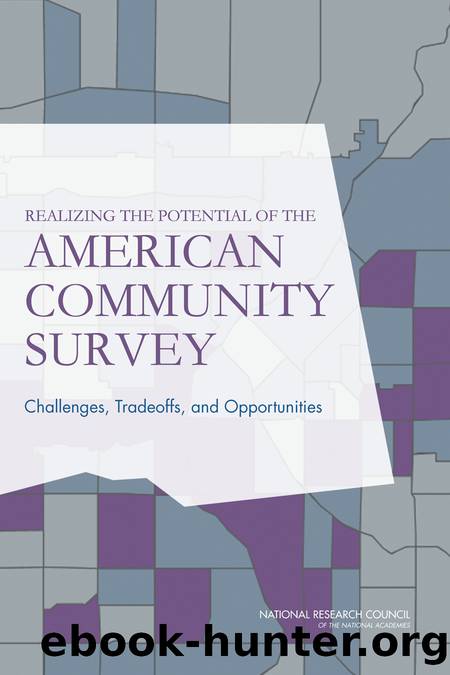Realizing the Potential of the American Community Survey: Challenges, Tradeoffs, and Opportunities by Panel on Addressing Priority Technical Issues for the Next Decade of the American Community Survey

Author:Panel on Addressing Priority Technical Issues for the Next Decade of the American Community Survey
Language: eng
Format: epub
Tags: ebook, book
Publisher: The National Academies Press
Published: 2015-03-04T00:00:00+00:00
SMALL AREA ESTIMATION
Previous chapters describe the effects of the reduced sample size of the ACS relative to the decennial census long-form sample on the precision of estimates for tracts and small governmental units. Domains defined by combinations of geography with demographic or other characteristics (such as âIranian immigrants over 65 years old in New Jerseyâ) suffer a similar loss of precision for direct ACS estimates. (Direct estimates refer to those based solely on data from the same primary information source in the same domain.) Estimates for areas or other domains for which direct estimates are not acceptably precise are commonly referred to as small area estimates or small domain estimates. (The latter term is technically more general but the former is more common; we use them interchangeably.)
Small area estimation generally involves introducing supplementary information beyond that included in direct estimation in each domain. Statistical models or procedures based on hypothesized relationships among the data sources are then used to obtain improved âindirect estimates.â Small area estimation is successful when at least on the average (although not necessarily for every small area) indirect estimates are closer than direct estimates to the target estimands, the quantities that would have been obtained if the primary information source had been available for the entire domain population.
Supplementary information used in small area estimation may take several forms. One form is information from the primary information source extended over time (e.g., using data from previous years of the same survey to improve estimates for the current year), over space (e.g., using data from a larger surrounding area to improve estimates for a small area), over domain definition (e.g., using data from two- and four-person families to improve estimates of small area median income for three-person families), or over survey mode or method (e.g., using mail responses to predict potential in-person interview responses, as suggested in Chapter 3). Another form is information from distinct information sources that contain âauxiliary variablesâ related to the variables of interest in the primary information source. Typically, these auxiliary variables are measured with better precision than the primary variables because of larger sample sizes in the auxiliary data, but conceptual differences or nonsampling errors make it unacceptable to simply substitute the auxiliary variable for the primary source (e.g., income and family composition data from tax returns as an auxiliary to ACS estimates of poverty rates, data from the previous decennial census as a source for population and housing characteristics when estimates are desired for a more recent year).
Given the diversity of characteristics of primary sources (sample sizes and design, scales of measurement and distributional characteristics of variables, patterns of variation across various dimensions, units of measurement, etc.) and auxiliary data (the same characteristics and relationships to the variables of primary interest), as well as differing definitions and requirements of accuracy, a large literature of small area estimation methods has developed (for reviews of this literature, see Ghosh and Rao, 1994; Rao, 2003; Jiang and Lahiri, 2006; Pfeffermann, 2002, 2013). Despite this development
Download
This site does not store any files on its server. We only index and link to content provided by other sites. Please contact the content providers to delete copyright contents if any and email us, we'll remove relevant links or contents immediately.
Cecilia; Or, Memoirs of an Heiress — Volume 1 by Fanny Burney(31352)
Cecilia; Or, Memoirs of an Heiress — Volume 3 by Fanny Burney(30950)
Cecilia; Or, Memoirs of an Heiress — Volume 2 by Fanny Burney(30907)
The Great Music City by Andrea Baker(21621)
We're Going to Need More Wine by Gabrielle Union(18086)
Bombshells: Glamour Girls of a Lifetime by Sullivan Steve(13120)
Pimp by Iceberg Slim(12947)
All the Missing Girls by Megan Miranda(12775)
Fifty Shades Freed by E L James(12464)
Talking to Strangers by Malcolm Gladwell(11909)
Norse Mythology by Gaiman Neil(11902)
Crazy Rich Asians by Kevin Kwan(8373)
Mindhunter: Inside the FBI's Elite Serial Crime Unit by John E. Douglas & Mark Olshaker(7850)
The Lost Art of Listening by Michael P. Nichols(6485)
Enlightenment Now: The Case for Reason, Science, Humanism, and Progress by Steven Pinker(6414)
Bad Blood by John Carreyrou(5782)
The Four Agreements by Don Miguel Ruiz(5533)
Weapons of Math Destruction by Cathy O'Neil(5048)
We Need to Talk by Celeste Headlee(4881)
